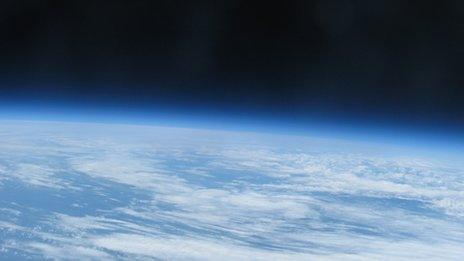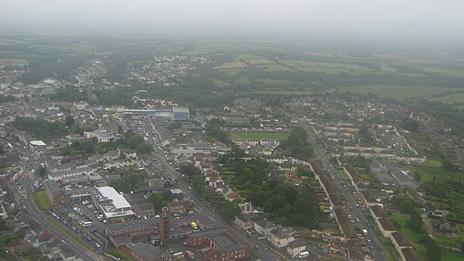Tasker Milward School balloon reaches edge of space
- Published

A photograph taken from the helium weather balloon at a height of 21 miles (34km)
Photographs of the Earth from the edge of space have been captured by a helium balloon as part of secondary school science project.
Children and teachers at Tasker Milward School in Haverfordwest, Pembrokeshire, said the balloon reached a height of 20 miles (33km).
The latex helium weather balloon had a digital camera on board and sensors gauging temperature and pressure.
It touched down in a field of cows near Trelech in Carmarthenshire.
The school's head of chemistry Jon Sharpe said the idea for the project came from sixth former Connor Goddard.
"Connor had seen some guys in Portugal trying this and they'd had three failed attempts," he said.
"He asked if he could try something similar and the teachers said, 'yes.'"
To raise the £2,000 needed to create the balloon, six teachers embarked on a 72-mile (115km) sponsored step in the school gym.
"We bought the balloon and the electronics and built the circuit boards for the balloon," added Mr Sharpe, who led the project with physics teacher Dorian Pascoe and IT technician Tom Griffiths.
"The payload is a bit battered and bruised, but it went from -40 degrees to +40 degrees in a matter of minutes and at one time was travelling at nearly 100mph (160kph).
"We were tracking it all the way and couldn't understand when it landed why it was still moving. When we arrived at the landing site we found a field full of young heifers.
"They must have been trying to play football with it."
Connor said the balloon, filled with enough helium to reach such heights and released from the school grounds, landed not far from where they predicted.
Speaking to BBC Radio Wales, he said: "Last night we were all very excited when we managed to get the box open to retrieve the camera inside.
"Luckily the lens hadn't been smashed inside when it landed and some of the pictures are amazing.
"We've got pictures when you can see the curvature of the earth, and all the cloud formations.

A image from the balloon soon after it took flight from Haverfordwest
"In some of the pictures you can actually still see the land below, you can see the coastline, but obviously you've got the blackness of space, and then the glow of the earth's atmosphere and the curvature of the earth itself."
Connor said the school had used experts to help to help predict where the balloon would land.
'Jubilant'
"We were tracking it all the time. We had two vehicles that were fully kitted out," he added.
"We were sort of driving around the county trying to follow the craft because the craft was constantly sending us information from the sky, relaying its longitude and latitude, its altitude, the temperature inside and outside.
"Even though we could sort of predict it was always going to be a bit of a gamble there was a very big chance, because three side of our county are surrounded by water, that it could have landed in the ocean.
"We really weren't sure if we were going to see the craft again, but we were all jubilant when we found it. It was sort of sitting in a field with a load of random cows."